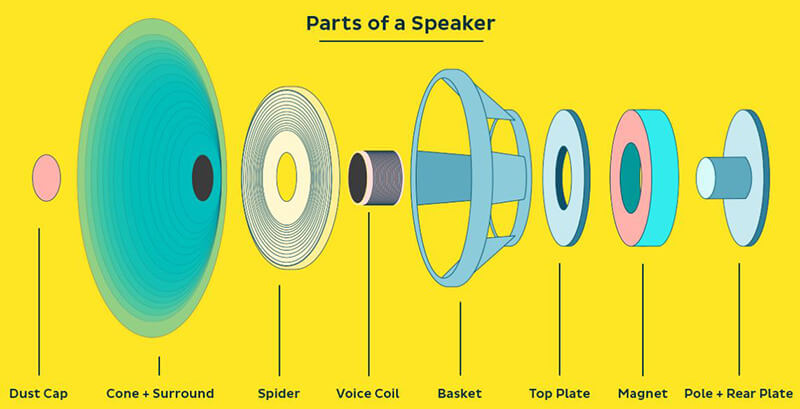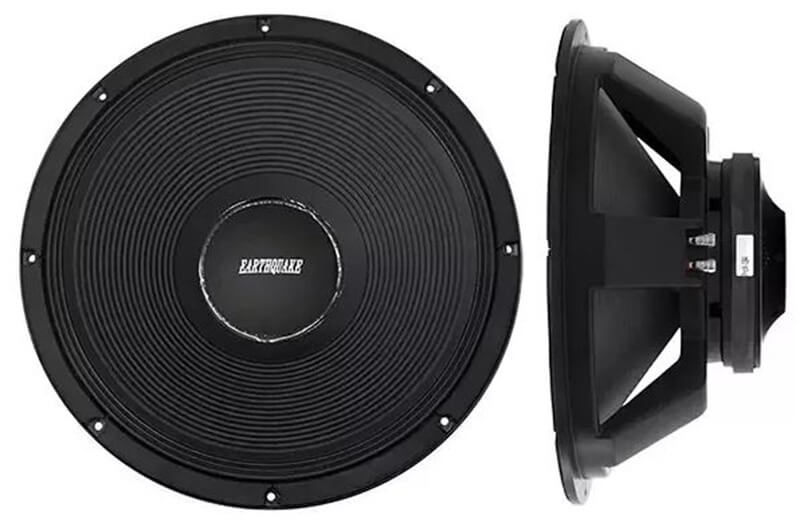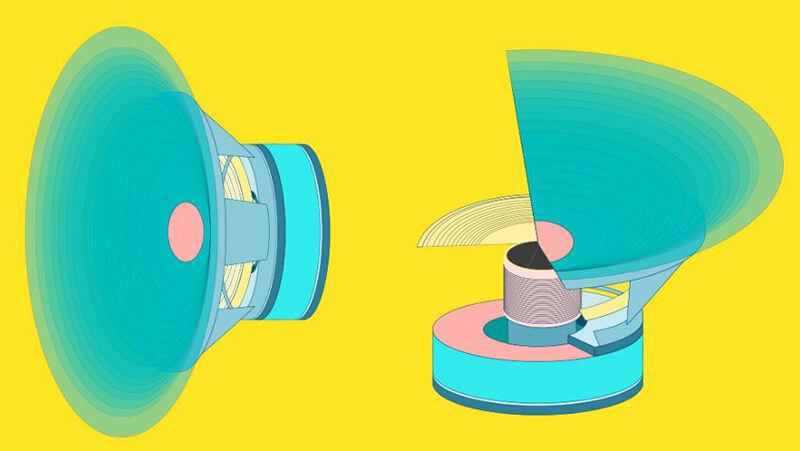Are you Looking for How does A Speaker Work? LessConf will show you many best practices which help you understand it here!
Speaker technology is the cornerstone of the sound world, powering everything from your vehicle infotainment system for your miniature in-ear Bluetooth headphones.
Although the majority of folks may not understand the intricacies of the speaker layout, understanding how speakers really work can make the difference between purchasing the correct or wrong part of the kit. Additionally, it is exceedingly valuable when fixing a beloved hi-fi installation.
The essentials of speaker technologies have not changed very much in roughly 100 years–similar to the inimitable TRRS headphone connector.
Edward Kellogg and Chester Rice’s 1924 lively speaker are nevertheless the most frequently used technologies now. Though there have definitely been improvements in quality and technology ever since that time.
How Can The Sound Operate With Regard To Speakers?
Sound moves in waves. When air pollutants are compacted and rarefied quickly enough, we hear it as noise.
The quicker the air pressure varies, the greater the”frequency” of the noise we hear.
When a speaker goes back and forth, it pushes air pollutants that affect the atmospheric pressure and generates sound waves.
[amazon bestseller=”Speaker” items=”10″ template=”list”]
How Does A Speaker Work Into Sound

Animation: The way the loudspeaker works. When the fluctuating electrical current flows through the coil (orange), then it turns into a temporary electromagnet, attracted and repelled from the permanent magnet (blue/red). Since the coil moves, it moves the cone (grey ) back and forth, pumping sound waves to the atmosphere (light blue).
After things shake around or vibrate, they create the noises we could hear from the world around us. Audio is invisible the majority of the time, however, occasionally you can actually watch it!
Should you thump a kettle-drum using a rod, you may observe the tight drum moving down and up really quickly for a while then –pumping waves to the atmosphere. Loudspeakers operate in a similar manner.
In the very front of a loudspeaker, there’s a cloth, plastic, paper, or lightweight metallic cone (sometimes known as a diaphragm) not as a drum skin (colored grey in our image ). The outer region of the cone has been secured to the outer region of the loudspeaker’s curved metallic rim.
The interior component is fixed to a what is the iron for clothes coil (occasionally referred to as the voice coil, colored orange in the structure ) that sits just in front of a permanent magnet (occasionally known as the field magnet( and colored yellow).
If you hook up the loudspeaker into a stereo, electric signals feed via the speaker wires (red) to the coil. This turns the coil into a temporary magnet or electromagnet.
Since the power flows back and forth from the wires, the electromagnet either attracts or repels the permanent magnet. This goes the coil forward and back, pulling and shoving the loudspeaker cone. Just like a drum vibrating back and forth, the moving cone pumps seem out to the atmosphere.
How Speakers Work: The Basics
The main principle of speaker technologies is that the transport of energy from 1 country to another. To be specific, transforming electric waves out of the playback device, make sure your telephone or a plastic player, into sound pressure waves from the atmosphere for your own ears to detect.
The mechanism employed to accomplish this is easy enough: The speaker cone (the round piece you may view ) vibrates, pushing and pulling the air to make sound waves.
The conversion from electrical to mechanical power happens through a coil and magnet combination connected to the cone. This coil moves the speaker cone back and forth because its electromagnetic field varies with the electric current (i.e. your audio ) passing through it.
But, speakers need a whole lot more energy to drive and pull on the atmosphere to generate noise than it will transfer electrons down a cord.
So speakers require an amplifier to improve the low power electric music sign into a greater power condition to push speakers. Modern solid-state amplifiers encourage present to produce sufficient levels of electricity, while elderly valve amplifiers operate at high voltages too.
Mobile and lower-powered house speakers consistently incorporate a built-in amp, ensuring optimum power transfer for your speaker.
However, stronger hi-fi speakers frequently need an external amplifier. This necessitates careful attention to be paid to output power and speaker impedance matching to be certain that the installation works properly.
What distinguishes the best speaker out of a speaker that is ok?
The greatest test of fidelity to get a speaker is how much like the waveform from the atmosphere (the strain wave) would be into the digital signal (the audio recording) which has been sent to the amplifier.
If each frequency is correctly reproduced to the listener without removing or adding any info it is probably a speaker.
There are lots of elements that determine how precise the listening experience will be like the frequency response, the quantity of distortion, as well as the directionality (dispersion) of this speaker.
How Speakers Create Noises Of Different Frequency And Volume
Loudspeakers will play loudly once the cone vibrates a massive amount or tender as it moves a little quantity. Why? Consider drums. Banging a drum skin actually hard, makes skin vibrate a larger space and produce a louder noise.
In precisely the exact same manner, sending a larger pulse of power into a loudspeaker creates the cone movement farther and creates a louder sound. Quieter sounds are created by smaller pulses of power.
We can achieve the exact same conclusion by considering energy. The laws of physics tell us we can not make energy from thin air. If we would like to generate a loud noise (one which conveys a lot of energy), then we will need to produce a vibration with a great deal of energy in the first place (in other words, hit something very tough ).
Some drums have pedals on these which make skin tighter or looser. If the skin remains tight, then it vibrates faster if you bang the drum and produces a higher-pitched noise; when the skin is loose, then the reverse occurs and you get a far lower note.
A similar thing occurs in a loudspeaker. Larger speakers with big cones (called woofers) move more slowly than smaller speakers using smaller cones (called tweeters)–therefore they’re better for producing lower frequencies.
Any speaker can produce a broad selection of various audio frequencies by transferring back and forth fast (for greater notes) or gradually (for lower notes).
Speakers which have to produce high-frequency sounds (or ultrasound, well beyond the assortment of human hearing) occasionally utilize piezoelectric transducers, dependent on waves that are vibrating, rather than the classic magnetic coil installation.
Frequently known as crystal loudspeakers or simply”buzzers,” they are also utilized to produce piercing noises in matters like phone ringers and smoke alarms, in which the potency of the alert is a great deal more significant than its quality.
The Internal Workings Of A Speaker
It is not simply the size of this cone which impacts the noise of your own speaker. Each internal components are able to create a noticeable difference to its own sound. The materials and form of the speaker enclosure have an effect, as noise absorbs and reflects the body off.
The plan of passive radiators and vents also promotes the frequency response of this enclosure. These are usually used as a passive EQ to improve certain frequencies that the speaker struggles with.
Additional important elements to audio really are found by breaking the speaker coil and cone itself. Every speaker is constructed in the following elements:
Diaphragm — like in our own bodies, this is the component responsible for moving and transferring the atmosphere. This term can be used interchangeably with cone.
Tweeter diaphragms can be made from thin ribbon, as an instance, although polypropylene vinyl has become the most frequent material. Other materials include fiberglass, carbon fiber, aluminum, and PET plastic, which affect the movement and weight of the cone.
Surround / Suspension — retains the diaphragm in place while allowing it to vibrate. Common encircle materials include foam and rubber.
Voice spiral — a coil of cable on the rear of the diaphragm. The voice coil responds to the magnetic field produced between the magnet when the current is pushed through the coil. This provides the power that moves the cone also produces noise.
Voice coils may either over or below hang the magnetic substance, which includes pros and cons for spiral mass, sensitivity, and motion linearity. Under-hung coils have a tendency to be earmarked for high-end speakers.
Magnet — this durable magnet stays behind the speaker cone, socializing with the shifting magnetic field to move the speaker. Different magnet dimensions and substances marginally change tonal attributes. Frequent materials include neodymium, thicker ferrite, alnico, or much more expensive samarium cobalt.
Basket/framework — an enclosure, usually metal, which includes each the aforementioned speaker parts.
Spider — sits between the diaphragm and also encircle as well as the basket/alloy framework, making sure they don’t touch.
While the core notion of speaker design is fundamentally the same over a massive assortment of products, there is a great deal of variation across these internal elements. Product function, price, and material options all affect the way the speaker seems.
Why Larger And Stronger Are Not Always Louder?

Broadly, the more sound you would like to make together with your speakers, the larger they will want to be. Why? Since the quantity of sound something makes is regarding the amount of noise energy that it sends out to the atmosphere.
Larger speakers seem louder since they have larger cones that could pump out more electricity each second, so they are stronger.
In the regular world, words such as”power” and”energy” are frequently utilized in rather a vague manner, but they have quite strict scientific significance.
In science, we measure energy in units known as joules (called for English physicist James Prescott Joule) and also the quantity of energy something produces in 1 moment is called its energy, measured in units of watts (named for Scottish scientist, James Watt).
Power of one watt means something is creating or using just one joule of energy each second. A typical 60-watt incandescent lamp carries in 60 joules of energy each second, although probably puts out just about 3–6 watts of drives and light another 54–57 watts as heat.
You may think a loudspeaker rated 100 watts would produce 100 watts of audio –but it isn’t quite that easy.
Speakers can also be pretty ineffective: much of this electric energy you feed in the rear of a speaker does not emerge in the front as audio energy however is wasted at the coil because of futile heat energy.
Ability
If you would like to compare the output of two loudspeakers, you may do it by placing them side by side, shifting them (subsequently ) up to the max, and walking off into the distance to find out just how far you can go before the noise disappeared.
In theory, an easier way to get the exact same end would be to learn their energy rating in watts and compare. That is what most individuals do if they purchase speakers or home stereo systems.
You might anticipate that the greater the number of watts, the louder and stronger your speakers will be. Therefore, by way of instance, those small Sony bookshelf speakers at the top photograph are rated a puny 7 g, whereas large, old-fashioned, house stereo speakers are more like to be rated at something like 50 watts.
But, straight power dimensions can be extremely misleading and therefore are often intentionally employed as an advertising trick by the amplifier and speaker manufacturers: two equally rated speakers can produce sound in rather different manners and in training, for a variety of reasons that I am not likely to enter speakers which promise to possess a higher energy rating may seem quieter than those using a lower power rating.
Additionally, but easy electricity ratings tell you nothing or little about how you are going to have the ability to use your speakers at the actual world: I was able to have some massive speakers which were so strong that I could never play with them in anything aside from the minimum quantity for fear of bothering my neighbors.
I needed to play with them so quietly they just never functioned properly. It was just like owning a Ferrari and pushing at walking pace.
Photo: Now that is what I call loudly! The colossal 1400-watt” loud hailer” loudspeaker across the side of the Sea Knight HH-46D helicopter was made for use during search and rescue missions at sea, but how loudly were 1400 watts in training? And was it loudly enough? Large outer picture by JO1 Snaza; pullout closeup photo by PH3 Sue Cain. Both pictures courtesy of Defense Imagery.
Sensitivity
Rather than electricity, it is often much better to have a look in a dimension known as the sensitivity of a speaker system, and that’s just how much sound the speaker produces in decibels at a distance of 1 meter to get an input power of one watt. (In effect, the sensitivity is a rough guide to the efficacy of a speaker–or just how much output it produces for every unit of input)
The greater the sensitivity, the more effectively the speaker is switching energy out of your amplifier to sound–and, frequently, the better it’s.
Most home speakers possess sensitivities of approximately 80–90dB; the small Sony ones at our top photograph come in at 82dB, so in case you place 1 watt of electricity into them and stand 1m away they will produce a perfectly commendable 82dB of audio.
The decibel scale is logarithmic, so tiny gains in decibels translate into quite much louder noise. Little bookshelf loudspeakers frequently pack a surprisingly strong punch because, though they have low energy evaluations, they have high sensitivity.
The near future of speakers: What’s Graphene and does this improve speaker performance?
Graphene is a trendy new substance that was initially found in 2004. It considerably improves loudspeaker functionality.
Graphene is the most powerful and lightest substance in life. As it is mild, it may move very fast, which makes it good for large frequencies.
Here at ORA, we have produced our own Graphene Oxide substance called GrapheneQ that is built specifically for music applications.
It is strength means it does not deform or distort as it goes back and forth, providing a higher-fidelity noise from speakers which may be smaller and more effective.
Conventional speakers are in fact among the least efficient technology which we still use now. Less than 1 percent of the energy which goes to a speaker becomes converted to noise.
The majority of the energy gets converted to heat. Conventional speakers are now less effective than incandescent light bulbs, that can be pretty much cuter at this time!
Since Graphene is really lightweight (it is only one-atom thick!) It requires a whole lot less energy to move forth and back.
Therefore, if you’d any wireless speaker or speaker in the marketplace these days and replaced its own membrane using our GrapheneQ substance, you’d instantly find a 70% battery life increase.
New materials and their programs will be the future of speaker technologies. They’ll fix the problems of efficacy and noise which speakers have suffered for decades.
Proceed to support ORA Sound and test their ORA GQ Headphones on their Kickstarter page. Stop by the ORA Website to learn about GrapheneQ as well as the ORA Sound narrative. Particular thanks to Ari Pinkas and Robert-Eric Gaskell for sharing their understanding.







